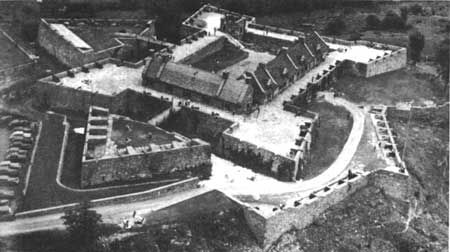
Fort Ticonderoga from the National Park Service
Hey, since we've been visiting old forts of late, we thought we'd continue the tour and take a jaunt to New York's Lake Champlain North Country and Fort Ticonderoga.
It was first know as Fort Carillon, when the French manned it between 1755 and 1759 during the Seven Years War. The fort was there to protect the lake's water route and a small trading post. It was surrounded by 20 foot high walls, and the fort, with its outliers and grounds, covered over 450 acres.
Carillon held off one Brit attack in 1758, but a year later, the redcoats overwhelmed it. And so began its first spook tale, that of Black Watch Major Duncan Campbell, who died during the first attempt to take the bastion, and the Inverawe Curse.
He was in his family's ancestral digs of Inverawe when he inadvertently hid the murderer of a clansman, his cousin Donald. Donald appeared to him from the astral plane shortly thereafter, chided him, and told Duncan "Farewell, farewell, until we meet at Ticonderoga." "Ticonderoga," the Major mused, "now where could that be?" He had never heard of the place.
Campbell found out soon enough, when a French cannonball sent him to join Donald in the afterlife. He's still buried in Union Cemetery; his family, recalling his perfidy, never reclaimed his body. Some locals and relatives with short memories gather on the anniversary of his death at his otherwise forgotten tombstone.
The fort would switch hands several times during the Revolution, but it wasn't until the British surrendered at Yorktown that the Americans could claim it once and for all. But with the war over, its military value plummeted.
The land became the property of the state of New York in 1785. William Pell bought the rundown fort and its grounds in 1820. He built "The Pavilion" by the lake to serve as a summer home, and then switched it over to become the Fort Ticonderoga Hotel in 1840 when the area became a nexus for canals, railroad lines - and tourists.
A couple of generations later, Stephen and Sarah Pell began restoration of the fort in 1909, opening it to the public with much hoopla; President Taft even showed for the festivities. Today, much of the fort has been restored, and is open as a museum and rental facility.
The Pavilion is said to be haunted by the ghost of Sarah Pell, who lived there in the 1920s and 1930s. She's been spotted gazing out of the window overlooking the King’s Garden.
The fort museum cleaning staff find that their collection pieces have been moved to different places, despite being in locked glass display cases. Red glowing orbs have been seen floating throughout several of the fort's rooms. Some claim that they've heard disembodied hoof beats, footfalls, and French voices, and seen misty silhouettes in the windows.
Several sightings of a red coated figure in one of the upper windows of the south barracks have been reported. The gate house staff have heard women crying outside the window when nobody is there.
Others have seen the ghost of a woman roaming the fort and the lake area. That would be the shadow of Nancy Coates, a local gal who was one of General Mad Anthony Wayne's main squeezes.
Convinced by catty Ticonderoga wagging tongues that Wayne had left her for another woman, Coates threw herself into Lake Champlain and drowned; her lifeless body to this day has been allegedly spotted floating in the water. She's been reported running along the footpaths near the fort by the entrance gate, too, waiting for Wayne to return to her arms, often sobbing.
Wayne’s ghost has supposedly been eyed in the fort's dining room, sitting by a fireplace, smoking a pipe and drinking from a pewter mug.
And hey, we haven't even mentioned Champ, America's version of Nessie, said to live in Lake Champlain's water since Native American days.
Anyway, you can read up on the fort's phantoms in the pages of Nancy Roberts "America's Most Haunted Places" and Michael Norman and Beth Scott's "Haunted Heritage." Ghost Hunters ran an episode about it. Paranormal investigators visiting the site outnumber its spirits.
The locals push its haunted history, too - it's a spooked out Halloween House, and they also offer summer Ghost tours.

1 comment:
if you go at midnight below the Fort Ti road near the old military road, at midnight you will probably encounter the headless horseman galloping down the road, attested to by many luckless boy scouts at jamborees there who dare to venture forth into the eerie darkness at midnight. This account is recorded in British war journals as an officer who was decapitated by a cannonball. Also the Old French Lines still had yellowed bones sticking up out of the ground there in the 1950`s, which I saw with my own eyes while hunting there with my dog and others.
Post a Comment